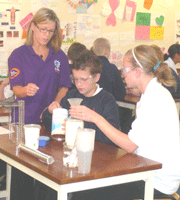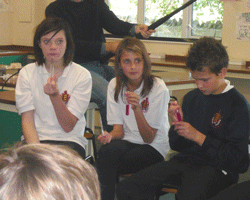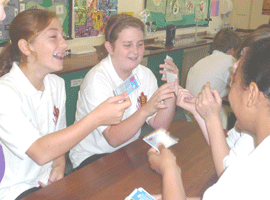Web-based campaign educates children about antibiotic resistance
Click Here to Manage Email Alerts
"Here at e-Bug, we deal with the problems that nobody else can."
This statement flashes across the computer screen as children playing a detective game on the European website — www.e-Bug.eu — undertake their first mission. The game mixes education about microbes and antibiotic use with entertainment and is only one component of a campaign designed to spread awareness about antimicrobial resistance. The message extends beyond the game and highlights the important role that patients, including children, play in fighting resistance.
 |
|
Junior school children from Gloucester,
England learning that microbes are alive through a yeast race
activity. |
"Antibiotics are the most common medicines given to children, and in many European countries, prescription rates are highest in this group," Cliodna McNulty, MS, BS, FRCPathol, e-Bug project coordinator and head of the Health Protection Agency (HPA) Primary Care Unit in the United Kingdom, said in an interview.
"Therefore, teaching young people about the role of antibiotics and microbes in schools may help to shape attitudes [about antibiotics] and help our future generation to use antibiotics only when appropriate and as instructed."
E-Bug targets two main groups of children — those aged 9 to 11 years and those aged 12 to 15 years, and involves educational materials that can be used by teachers in the classroom.
Detailed lesson plans, for example, on the scientific aspects of microbes, antimicrobial use and proper hygiene practices are accessible for download. Videos, interactive worksheets, take-home material and classroom activities are also available through the website.
 |
|
Children from Elmbridge Junior school,
Gloucester making microbes. |
Additionally, e-Bug offers platform games for both age groups, Donna Lecky, PhD, MRes, e-Bug project manager and HPA member, said at the 2010 International Conference on Emerging Infectious Diseases.
Young children are able to photograph cartoon microbes, for example, or learn how to properly store groceries. Older children — who may have a better understanding of microbes — can play a more science-based, crime scene investigation game in which they solve mysteries involving food poisoning or disease outbreaks.
The website also provides links to national curricula, lists of equipment needed for activities and background information for teachers who do not have a degree in science, Lecky said.
Although e-Bug has been accessible since 2009, additions are always being considered.
"[Ideas] include downloadable clipart of pack artwork and photographs of microbes to use in projects; revision guides to help refresh student memory; quizzes and disease fact files; and links to various campaigns, such as Global Handwashing Day and European Antibiotic Awareness Day," McNulty said, noting that these supplements will be available for translation into European Union languages this month.
 |
|
Students from Chipping Sodbury Senior school,
England demonstrating that it is better to catch a sneeze in a tissue than in
your hand to prevent the spread of microbes. |
Project development
The program's construction relied on student and teacher focus groups, according to McNulty. "During pack and website development, the artists and resource developers worked closely with young people and teachers to perfect the characters and activities," she said.
Children's opinions were especially important when creating characters, Lecky said, as students needed to be able to relate to them.
After sketching cartoon-like figures of microbes and human characters, researchers collected feedback from students. Lecky said younger children wanted bad microbes to appear menacing but thought good ones should look bright and friendly. Older children, however, preferred more realistic representations of microbes and wanted the human characters to be adolescents.
Teachers' input mainly addressed the ability to integrate e-Bug into the curriculum. "[The teachers] must be able to adapt e-Bug and its materials to specific classroom needs," Lecky said. "It’s important to have [information technology] and web links, and the material also needs to cover a range of learning styles."
 |
|
Senior school students from Chipping Sodbury
learning how microbes can be useful in the food industry through a yogurt
making activity. |
After collecting these data, the project developers created content for the educational packs.
Lecky said the first part of the pack provides a basic introduction to microbes, with particular emphasis placed on the existence and purpose of useful microbes, as the e-Bug team said these organisms receive little focus.
In the next section, the materials describe harmful microbes and detail ways in which children can protect themselves through good hygiene practices and vaccination. Additionally, SYDs were addressed in the packs for older children.
 |
|
Students observe how easily infections can
pass from person to person. |
Evaluation of success
After the program's launch in 2009, researchers conducted quantitative and qualitative analyses in various European countries.
The quantitative evaluations involved a series of questionnaires that were administered to children before integration of e-Bug into the curriculum, immediately after and then 6 weeks after sections were taught.
Results indicated significant knowledge change and retention in both age groups when using e-Bug compared with normal control resources, although data from several study sites involving older children did not denote progress, according to Lecky.
For qualitative analysis, researchers asked children whether they liked or disliked activities using a scale of one to five. In England and France, data suggested that students liked the majority of activities because of the hands-on approach.
"The children particularly enjoyed the lessons with the greatest interaction," McNulty said. "The respiratory hygiene lesson, for example, which features the 'Snot gun' is a particular favorite, as they squirt green snot down a 'snot runway.' The lessons that demonstrate spread of microbes using fluorescent lotions or dust are also very popular, as children are amazed at how far microbes can spread."
 |
|
Students observing how many people can become
infected with microbes from a sneeze while at a party. |
Most teachers also said they would use the e-Bug pack again, although those who said they would not cited problems with a lack of media support and the length of time that some activities require.
"Following the evaluation, modifications were made to the antibiotic and vaccine activities in the junior and senior packs to make them less complicated for teachers and more appealing to students," McNulty said. "The graphic design in both packs was also modified to simplify photocopying for teachers."
International cooperation
McNulty secured funding for e-Bug in 2006, with 18 different countries across Europe agreeing to collaborate on the project.
Ten countries served as associate partners, including Belgium, the Czech Republic, Denmark, France, England, Greece, Italy, Poland, Portugal and Spain. Collectively, these countries represented about 55% of the entire European population, McNulty said.
Another eight countries — Croatia, Finland, Hungary, Ireland, Latvia, Lithuania, Slovakia and Slovenia — also participated as collaborating partners.
 |
|
Students from Chipping Sodbury Senior School,
England, getting to know different microbes through a fun, introductory card
game. |
After drafting universal goals, researchers conducted studies on each country’s educational structure and decided where e-Bug would fit best in the national curricula. Although challenging, McNulty said the most enjoyable part of the process was learning how to integrate the program in diverse cultures.
"Our partners were extremely enthusiastic and the workshops we had to discuss the activities allowed the partners to have sufficient input to give a sense of ownership to each country," she said.
In September 2009, David Heymann, MD, assistant director-general for health security and environment of WHO and chairman of the board for HPA, launched e-Bug at a meeting of all partner countries in London. Since then, the educational packs have been translated into all European Union languages, with other countries expressing interest in the project. – by Melissa Foster
For more information:
- www.e-bug.eu
- Lecky D. Public awareness campaign in England and e-Bug. Presented at: 2010 International Conference on Emerging Infectious Diseases; July 11-14, 2010; Atlanta.
